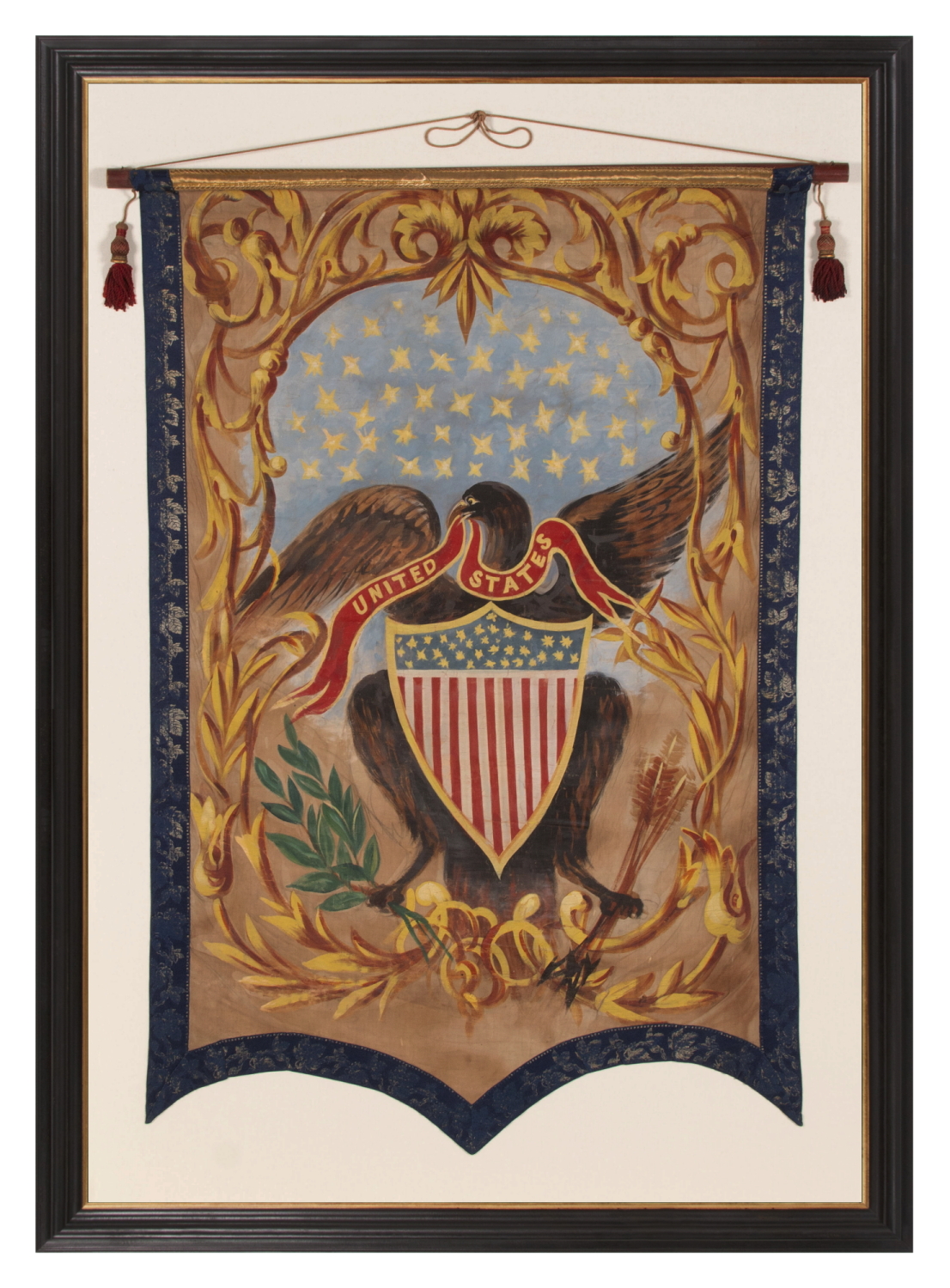
| |
HAND-PAINTED BANNER WITH FLORIATED SCROLLWORK SURROUNDING A WHIMSICALLY PAINTED FEDERAL EAGLE, WITH 46 STYLIZED STARS ABOVE AND 34 STARS ON ITS 21-STRIPE SHIELDED BREAST, circa 1907-1912 |
| |
|
| Dimensions (inches): |
Frame - Approx. 70.5" x 50", Banner - 58.5" x 38" (with rope 62.5" t, 43.25" wide at staff) |
| Description: |
|
This exceptionally colorful banner, hand-painted on tan cotton, features a whimsical federal eagle surrounded by floriated scrollwork. Grasped in its beak is a billowing red streamer, trimmed and lettered in gold, that reads “United States.” In its talons are the familiar olive branch and arrows, the former of which is in the direction of the eagle’s gaze, to indicate a time of peace. Above are 46 stylized stars, some 5-pointed and some with 4 points, a number of which display fine rays extending from between the arms. Upon its breast is a federal shield with 34 stars and 21 stripes. The textile is affixed to tomato red-painted staff with metal tacks, adorned with a gold-braided cotton cord and wine red, woolen tassels, decorated with the golden netting and trim. A piece of gold, silk, military trouser trim adorns the staff along the top edge. The left, right, and bottom edges, the latter of which bears a scalloped edge, are bound with a Navy blue silk damask, probably of French origin, with scrolling ivy in light gold thread.
The count of 46 probably reflects the time of the banner’s production, between the 1907 addition of Oklahoma as the 46th state and the 1912 addition of New Mexico. The style bears distinct elements of the Art Nouveau period, carrying over from Arts & Crafts, with some European influence and a fine art sensibility. The result of this is curiously as much folk art as fine art. Note the tall and narrow shield, the presentation of the wings, with one up and one down, and both groups of stars.
Though in some senses the banner has an earlier feel, the textile is actually shares traits with others I have seen, painted in New York in the WWI (U.S. involvement 1917-1918) – 1920’s era. I believe that the maker was more regularly employed to produce religious views, but was occasionally commissioned for patriotic works. The banner would be especially appropriate for display at World’s Fairs, that demanded eye-catching and artistically stimulating appeal in unforgettable presentations.
The count of 34 stars on a 21-striped shield may display Union sympathies. 34 was the count on most Civil War flags produced in the war’s opening years, between 1861 and 1863. 21 was a common Southern-exclusionary count that reflected the number of Union States during the same time frame (34 states less 13 accepted by Jefferson Davis and the Confederate Legislature.
If painted in Chicago instead of New York, 21 could reflect the fact that Illinois joined the Union as the 21st state in 1818. In truth, both this and the Southern-exclusionary use of 21 stripes seem a bit far-fetched in this instance, though the possibility is certainly intriguing. Though to a lesser degree, the same goes for the 34 star count, which may be purely decorative. Note that one of the stars is so tiny that one is forced to wonder whether or not a total can really be judged by including it. Whatever the case may be, the time period in which the banner was made was high time for reunions of Civil War veterans, that reached their peak at the 50th anniversary of the Battle of Gettysburg in 1913.
All-in-all, an extremely beautiful piece of patriotic American art and an extraordinary survivor.
Mounting: The banner was mounted and framed within our own conservation department, which is led by expert staff. We take great care in the mounting and preservation of flags and have framed thousands of examples.
The flag has been hand-stitched to ivory-colored hemp fabric. The black-painted molding, with its wide, sculpted profile and gilded inner lip, is Italian. A deep shadowbox was created to accommodate the staff and tassels. The glazing is U.V. protective acrylic (Plexiglas).
Condition: In an exceptional state of preservation. There is extremely minor paint loss and some craquelure. Pencil marks of the art’s sketch, prior to painting, can be seen in various places. |
|
|
| |
|
| Primary Color: |
gold, blue, tan |
|
| Earliest Date: |
1907 |
|
| Latest Date: |
1912 |
|
| For Sale Status: |
Sold |
|
| Price |
SOLD |
|
| E-mail: |
info@jeffbridgman.com |
|
 |
|
Page Views:... 199 |
|


